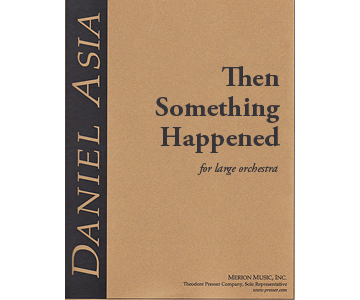for large orchestra
Scoring
3(picc)-3(EH)-3(bass)-3(Cbsn) / 4-3-3-1 / timp+4 / pno, hp / strings
Duration 5 Minutes
Commissioned by
the Tucson Symphony Orchestra
Performances
Tucson Symphony Orchestra
Program Notes
THEN SOMETHING HAPPENED was written in the spring of 1999. The work, subtitled “a languid dance”, is for the most part, rather gentle in nature, emphasizing the gentle alternation of sixteenth and eighth notes. It might best be thought of as a hybrid dance, one that combines a gentle swaying motion, with a hint of the exotic, perhaps a Tucsonan samba, with a dash of Tango and Watusi added for spice. Most of the action is in the winds, brass, and percussion, witht he strings along for the ride. Something does indeed happen towards the end of the paiece, namely a climax that tears asunder the rather steady musical universe that has been presented up to that point. But all is put aright and correctly again in no time, and the work ends close to where it began, but punctuated with a question mark. (Humpty-Dumpty has been put back together again, but a few cracks of wear and tear do show.)
For those who take stock in, and find interest in knowing the origination of titles, this one is close to that of a book by Joseph Heller. Suffice it to say, that the story, written in stream of consciousness mode without any punctuation (help!), is in fact, highlighted by only one major occurrence in its over four hundred pages. It is an intensely personal story, but one that may have more universal implications. This may be heady associations for a short five minute musical overture, but I figured, in the spirit of the piece, ‘what the heck’.
The original materials of the piece were first explicated in an electro-acoustic work, Chromium, co-written with then DMA composition student, Kip Haaheim (now Doctor) , during the Fall/Winter 1999-2000, in the Electro-acoustic Music Studio of the School of Music and Dance at the UA.
The work is dedicated to the Tucson Symphony Orchestra and its music director George Hanson, who commissioned the work for this 1999-2000 season.
Reviews
K. KEUFFEL, JR., ARIZONA DAILY STAR
This work, which began life as an electronic composition, is refreshingly different: It ends not with a bang, but with a soft, beguiling wind chord that leaves us questioning… Along the way, there’s some lovely almost antiphonal writing for brass choir and some interesting sound effects from the percussion section (the timpanist strikes a cymbal lying on a drum).
D. BUCKLEY, TUCSON CITIZEN
A heavily syncopated piece…, the score percolated sonic bits around the orchestra nearly constantly to create shifting arrays of color and texture. Utmost accuracy and perfect fit were demanded of every player. Yet Hanson and his forces dotted every I and crossed every T of the mosaic patchwork.
